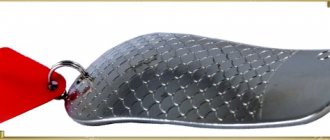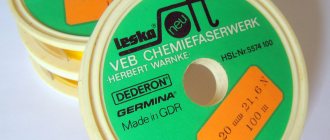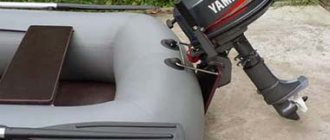Developers and manufacturers of outboard motors, as a rule, do not set themselves the task of equipping the latter with any measuring instruments. This is due to the fact that boat engines are incomparable in complexity to engines for a car or motorcycle. They are much simpler and therefore do not require any measurements of operating conditions during operation.
However, the operation of outboard motors has shown that in many cases it is extremely necessary to know the real engine speed, but, unfortunately, it is impossible to determine them without a special measuring device. To determine the speed of the outboard motor in real time, a device called a “tachometer” is used.
Its use allows:
- make precise adjustments to the motor;
- choose the right one;
- select the most economical engine operating mode;
- prevent motor failure by determining whether there are malfunctions in its operation.
Types of tachometers for outboard motors
Any tachometer works as a pulse counter in the engine's electrical system, which is directly related to the speed of its crankshaft.
Unlike a car engine, a boat tachometer most often receives information not from the ignition system, but from magdino coils (“dynamo + magneto”), which on outboard motors act as a generator.
There are motors in which there is no signal from the generator. In this case, induction type tachometers are used (with their own power source).
The data obtained by the tachometer is recalculated and displays the value of the number of revolutions of the engine shaft per unit of time on the liquid crystal display screen or dial indicator.
Tachometers are classified according to several parameters and are:
- universal
, that is, suitable for different types of engines; - designed to work with a specific type of engine
(two-stroke or four-stroke).
In addition, tachometers are divided into
- analog
, in which the engine speed is displayed on a dial indicator; - digital
, where information about the number of engine revolutions is displayed on a digital display.
Digital tachometers can additionally be combined with other measuring instruments, for example, a counter of engine hours that a boat engine has worked.
General description of the device
The tachometer is a small device that is installed on the engine. A simple mechanism allows you to read information without direct connection to the installation using a power wire from the spark plugs (SZ). The obtained data on the mileage and the number of revolutions are displayed on the screen.
Depending on the display of information on the monitor, devices are divided into analog and digital. In analog instruments, the speed parameters of the outboard motor are displayed by a pointer indicator. The sensors convert the electronic signal and output it to the indicator. Analog tachometers for outboard motors consist of the following components:
- electronic microcircuit;
- electrical wiring;
- graduated scale or LEDs attached one after another;
- pointer indicator of current values;
- electromagnetic coil with an arrow axis;
- reading device in the form of a breaker or inductive sensor.
In digital devices, information is displayed on a digital display. They convert the analog pulse into numbers that are recognized by microcontrollers. Digital tachometers include the following mechanisms:
- 8-bit analog-to-digital converter;
- main processor, which converts the analog signal into serial values 1 and 0;
- LCD display;
- a reversible chopper sensor used with an amplifier or shunts, depending on the device;
- reset chip.
Such devices are additionally equipped with various meters, such as temperature, pressure or speed sensors.
Tachometers are divided into:
- universal, suitable for all types of motors;
- special, designed for two- or four-stroke engines.
There are power plants on the domestic market that do not have a generator signal, so induction-type tachometers with their own power source (PS) are suitable for the boat.
How to choose
The existing market for tachometers for outboard motors is quite diverse and is represented by both models of well-known brands and products of unknown companies. In addition, you can find fakes on the market.
Therefore, first of all, you need to choose a reliable seller (ask where friends and acquaintances bought tachometers, look at reviews on online forums, etc.).
When choosing a tachometer, you need to pay attention to such factors and design features as:
- Tachometer functionality.
There are instruments that only show the speed of a boat engine.
But there are also tachometers, which, in addition, have the ability to display the following engine parameters:
- number of engine hours;
- temperature;
- oil pressure and much more;
When choosing a tachometer, you need to proceed from the fact that many functions are only possible with special sensors, the installation and installation of which is quite complicated. Most owners of motor boats believe that the optimal choice is a tachometer with a function for calculating the number of engine hours.
This function is important when the engine is new, as well as for determining the remaining engine life. To do this, you need to choose a device that displays the number of engine hours both during one trip and their total number since the start of operation.
- Compliance of the technical characteristics of the tachometer with the parameters of the outboard motor.
It is important to know here that there are tachometers that have built-in operating mode switches depending on whether the engine is used, two-stroke or four-stroke; do not have operating mode switches and are designed to work with one type of engine from different manufacturers; designed to work with engines of a specific manufacturer. For example, DF series motors are only available with 12-pole generators. - Easy to install, install and configure.
- The tightness of the device.
In most tachometers, sealing is ensured structurally, so the power source can only be replaced by disassembling the housing. However, there are tachometers that provide the ability to replace batteries without disassembling the case. This undoubtedly convenient feature can lead to water getting inside the tachometer housing, which will lead to its failure. - Compactness of the device.
- Tachometer cost.
It is of no small importance for a certain category of buyers, inducing them to choose a Chinese manufacturer. However, even among Chinese-made tachometers there are reliable models made with high quality. In addition, well-known manufacturers often offer universal, combined devices, some of the functions of which may not be needed at all, but will significantly increase the price of the tachometer.
In addition, when choosing a digital tachometer, you must ensure that you have sufficient:
- speed (frequency) of updating information on the display;
- brightness and clarity of the display of numbers on the display, especially in sunny weather.
Installation
Installing a tachometer is not difficult and is accessible to almost every motor boat user. Depending on the design, it is installed either in the dashboard of a boat or boat, or directly on the tiller (outboard) motor.
First you need to perform several simple operations:
- determine the location where the tachometer will be installed;
- determine the required wire length;
- if the tachometer is installed in the dashboard, cut a hole according to the dimensions specified in the instruction manual;
- purchase or make your own wiring harness that will connect the tachometer to the outboard motor. It is recommended not to skimp on the harness. It is better to purchase a branded harness of the required length, since its wires match the color of the connection diagram given in the instructions, and also have cable lugs and waterproof connectors. This will avoid mistakes during further installation;
- Using the installation elements included in the delivery set, secure the tachometer in a prepared place (boat dashboard, engine hood).
This completes the preparatory work and installation of the tachometer and installation work can begin.
The installation method also depends on the design of the tachometer:
- If the tachometer does not have its own power source, then it reads pulses directly from the magneto coils, where the cable needs to be connected.
- If the tachometer is equipped with its own power source, then to connect it you need to twist the connecting harness around the spark plug wire with several turns. The number of turns and the distance to the spark plug are specified in the instruction manual (approximately 3 to 6 turns at a distance of 4 cm from the spark plug). Then the harness is connected to the tachometer terminals.
The connecting cable must be laid in such a way that it does not come into contact with hot or moving parts of the motor. All connections must be made according to the tachometer connection diagram. If all connections are made correctly, then after starting the engine, the tachometer immediately begins to show the number of revolutions.
In order for the indicated engine speed to correspond to reality, you need to adjust the tachometer.
Principle of operation
“>The connection of the tachometer to the outboard motor occurs through spark plugs, the power wire of which actually acts as a conductor, which transmits electrical impulses to the device. The received information is displayed on the device display.
Data regarding engine speed is generated in real time. If we talk about the accumulated engine hours, the indicator is displayed only after the drive stops operating.
If necessary, the tachometer for an outboard motor can be reset. In other words, reset data for a certain period.
Settings
In general, setting up a tachometer comes down to setting its operating modes, which correspond to the operating modes of the connected motors.
Therefore, if:
- The tachometer is designed to work with motors of the same type from different manufacturers, or their different types from only one manufacturer (all this is indicated in the accompanying documentation), then when starting the engine, the tachometer must show a fairly accurate number of revolutions. The accuracy of the readings is checked by comparing the engine speed at idle, indicated in the operating manual, with the tachometer readings when the engine is running in the same mode. If the indicators do not match, you can bring them into compliance following the instructions.
- The tachometer is universal, then you need to set the operating mode selector to the position corresponding to the number of pulses per revolution of the engine crankshaft - if the device is connected to a magneto. In this case, the type of engine does not matter, and the number of pulses is indicated in a special table attached to the instruction manual, and the type of engine (two-stroke or four-stroke) - if the device is connected to a spark plug wire. The number of cylinders does not matter.
Setting the operating modes of tachometers is carried out only with the outboard engine turned off.
Operating principle and functionality
The operating principle of electronic devices for outboard motors (outboard motors) is based on the induction method. The tachometer reads signals in the engine's electrical system. They come from Magdino coils. The magneto-dynamo pair plays the role of a generator. The number of pulses per revolution of the crankshaft corresponds to the number of magdino lighting coils, or pole pieces. There can be 4, 6, 8 and 12. Reading pulses is not related to the number of cylinders and strokes, which allows the device to be used for both a two-stroke engine and a 4-stroke engine with a number of cylinders from 2 to 6.
To set the poles, there is a switch on the back of the device that corresponds to the number of poles.
Often, boat owners install car tachometers that read pulses from the ignition system from the SZ wires through the insulating material. In a 4-stroke engine with 4 cylinders, to generate a spark from the SZ, 2 pulses are generated per 1 revolution.
Review of popular models
Manufacturers of outboard motors, as a rule, do not make measuring instruments for them. This task is assigned to partner companies. For example, Teleflex Marine produces a large number of tachometers with the Mercury logo. At the same time, it also produces Osculati tachometers and branded Teleflex.
Also, a number of other companies (China, Taiwan) produce a large number of tachometers with Yamaha and Suzuki logos. Therefore, professionals suggest not focusing on the “native” brand of tachometer and, when choosing it, be guided by practical expediency.
Let's look at several of the most popular models of tachometers for outboard motors:
- Yamaha.
The digital multifunctional tachometer 6Y8T-8350T-11-BK is housed in a waterproof housing. Designed to fit into a standard 86mm instrument panel hole and is used with Yamaha engines from F50 and above. The display shows the current and maximum engine speed, as well as the number of engine hours. The cost of the tachometer is 23,615 rubles.
Cost – 23615 rubles.
- Mercury.
Flagship analog tachometer (0-8000 rpm) is designed for installation on all Mercuri engines. It has a waterproof case with anti-fog glass, as well as a pointer dial. The price of the tachometer is 5620 rubles.
Price – 5620 rub.
- Suzuki.
Analog tachometer for DF9.9-30/DT25-40 engines – installed in a standard hole in the boat’s dashboard (86 mm). It has anti-fog glass and shows up to 7000 engine rpm. It does not have an operating mode selector, since all Suzuki DF/DT series engines are equipped with 12-pole generators. Its price is 4400 rubles.
Price – 4400 rub. The tachometer is the most important instrument on a powerboat. The tachometer
is given a central location on the boat's dashboard.
A tachometer
is simply necessary to control engine speed when selecting a propeller - the engine must develop the maximum speed recommended by the manufacturer by selecting a propeller. To ensure speed, resource and efficiency.
Tachometer
— is a pulse counter in the engine electrical system, directly dependent on the crankshaft speed. The measurement results recalculated by the device are reflected either by a regular arrow on the dial or in the form of numbers on the liquid crystal display.
The tachometer for a boat can be of two types - digital and analogue
In the age of widespread digitalization, this could not help but affect tachometers for boats - many cheap digital tachometer models have appeared. But nevertheless, as a rule, a pointer device is used as a tachometer on a boat - the human eye perceives analogue information in the form of the angle of rotation of the needle faster than its digital value, especially since high accuracy is not needed while the boat is moving.
Car tachometer for boat
Car tachometer
- counts pulses in the ignition system circuit - a four-stroke four-cylinder engine gives 2 pulses per crankshaft revolution to form a spark on the spark plugs.
Outboard tachometer
— counts electrical impulses from magdino (magneto) coils. The number of pulses per revolution of the crankshaft will correspond to the number of coils - four, six, eight...
Therefore, it will not be possible to install a car tachometer on a boat without a file (soldering iron).
Analogue tachometer on a boat
Analog tachometer operation
carried out according to the electronic principle - the signal from the shaft is transmitted through wires to a microcircuit, which in turn sets the movement of the needle on a graduated scale.
Pointer tachometer
— a pulse counter from the magneto ignition system
an outboard engine
, works equally on both four-stroke and two-stroke engines. The number of pulses is determined by the number of magneto (magdino) windings.
The tachometer scale of a boat motor usually has a maximum value of 6000 rpm. For most outboard motors, the maximum recommended speed is 5500 rpm, the exception is the Suzuki DF140, where the maximum speed is 6200 rpm (maybe something else, I don’t know...).
So 6000 rpm. on the tachometer scale for a boat is quite enough, and due to the larger division value, you can read the instrument readings more accurately.
Installation and connection of the tachometer
When installing the tachometer on the instrument panel, you need to choose a place where it will be clearly visible, preferably not blocked by the steering wheel. The standard hole diameter for the tachometer is 87mm
.
Don't be alarmed when buying a tachometer, if the arrow of the device does not lie at the 0 mark, it will fall after you connect it.
Installation on the boat and connection of the tachometer
very simple - any pioneer can do it, not to mention a vodka-motor driver, especially if you have a branded cable that costs $20-30 - all that remains is to connect the connector.
If there is no “RANGE SELECTOR” on the tachometer, it depends on the number of coils on the magneto of the boat motor. This is due to the fact that outboard magnetos differ in the number of poles, so they produce a different number of impulses per revolution of the crankshaft.
.
To independently determine the number of pulses created per crankshaft revolution, you need to divide the number of poles by two, but you can use the table below:
| Manufacturer/Model | Number of generator poles | Tachometer switch position |
| EVINRUDR/JOHNSONR/OMC SEADRIVER/: | ||
| Less than 70 hp (2 stroke, 2 cylinder) | 10 | 5P |
| FORCE (MARINE): | ||
| 50 hp (until early 1987, models A, B) | 8 | 4P |
| All other models | 12 | 6P |
| HONDA | ||
| 35/40/45/50 hp with generator | 6 | 3P |
| Other HONDA models with generator | 4 | 2P |
| MERCURY/MARINER: | ||
| 2-stroke models: | ||
| 6-25 hp (made in USA) | 8 | 4P |
| 30/40 hp, USA serial number 0G53314 onwards | 12 | 6P |
| 35/40 HP, USA Serial #582399, Belgian Serial #9298955 and up | 8 | 4P |
| All other 2-stroke models | 12 | 6P |
| 4-stroke models: | ||
| 8/9.9 hp | 6 | 3P |
| All other 4-stroke models | 12 | 6P |
| SUZUKI: | ||
| 2-stroke models: | ||
| less than 55 hp, (except as indicated below), 60/65 hp. until 1985 incl. Cabrea 50-60 hp | 4 | 2P |
| 25/30 hp (since 1993); 55/65 hp (since 1985) | 6 | 3P |
| 75 hp and higher (from 1985 and newer); Cabrea 75 hp and higher | 12 | 6P |
| All 4-stroke Suzuki models | 12 | 6P |
| TOHATSU/NISSAN: | ||
| All 2-cylinder models with generator | 4 | 2P |
| All 3 cylinder models | 6 | 3P |
| All 4 cylinder models | 12 | 6P |
| YAMAHA: | ||
| 2-stroke models: | ||
| 9.9/15 hp | 4 | 2P |
| 25-70 hp | 6 | 3P |
| 90-250 hp | 12 | 6P |
| 4-stroke models: | ||
| F/T 9.9 hp, F 15 hp | 6 | 3P |
| F/T 25 - 225 hp | 12 | 6P |
| SELVA: | ||
| 2-stroke 9.9-100 hp, 4-stroke 8-15 hp | 6 | 3P |
| 4-stroke 25-115 hp | 12 | 6Р |
Additionally, a list of motors and the number of magneto coils can be found here
—
The engine of a modern boat motor is a much simpler thing than, for example, a motorcycle or car engine and does not require special measurements of the operating mode. Probably, partly because of this, manufacturers extremely rarely supply outboard engines with various kinds of electronic devices, which, as a rule, are equipped with other more complex internal combustion engines. However, there is one useful thing that is still worth purchasing for your outboard motor if you want it to serve you faithfully for a long time. This is a tachometer that will allow you to determine the actual engine speed and the total number of hours of its operation (motor hours) - an indicator similar to the mileage of a car.
A tachometer is a fairly simple, compact device that is installed directly on the outboard motor without interfering with its design. It is usually designed in such a way that it is able to read the pulses that travel along the spark plug power wire directly through the insulation. By the number of pulses read, the tachometer determines the exact number of revolutions that the engine has produced, as well as the total operating time of the engine. Information about certain indicators is displayed on the device’s display depending on its operating mode.
So, why does a boat motor owner need a tachometer?
The first is for proper running-in of your outboard motor.
Any new engine requires a break-in, which must be carried out for a certain time at strictly defined engine speeds specified in the engine passport. The significance of this stage is difficult to overestimate, since its further operation and service life will depend on how competently the outboard motor engine was run in. It is very easy to overload a new engine by setting the speed too high. Insufficient or too many engine revolutions can significantly reduce its service life and lead to operational problems. It is almost impossible to determine this by ear. Knowing the exact number of engine revolutions, which the tachometer measures, will help avoid this. Also, during break-in, it is important to know the exact number of hours that the engine has driven. This becomes especially important when the running-in is carried out with large breaks in time and the person doing the running-in can simply forget how many hours he drove the last time. The engine hour meter function on the tachometer will allow you to accurately measure engine operating time and avoid any errors in this regard. In addition, the hour meter function will be useful to you in the future when operating your outboard motor. It will allow you to track the time of a particular trip or find out how many hours of driving one tank of fuel lasts.
Secondly, a tachometer is needed to diagnose problems with a boat motor.
How can you use a tachometer to identify problems with the engine?
First of all, you need to pay attention to his testimony. The tachometer makes it possible to monitor how well the engine characteristics stated in the passport correspond to its actual speed. To do this, you need to pay attention to the tachometer indicators with the throttle turned to the maximum and at idle engine speed and compare these indicators with the data indicated in the passport. If the readings are different, this may indicate that the engine is not working correctly.
Third, to improve engine speed.
This point is directly related to the previous one.
It would seem, how can you increase the speed of the engine using a tachometer? This can be done. First of all, it is important to understand that the speed of a boat is influenced by the power of the motor, the total weight of the boat and the correctly selected propeller. A tachometer is needed just to select the optimal propeller for your engine under the conditions you specify.
So, let's say your outboard motor does not develop rated speed at maximum gas. This indicates that the motor is heavily overloaded, heats up, and this not only negatively affects the speed characteristics of its operation, but can also lead to motor failure, all due to an incorrectly selected propeller. Or the opposite situation - the maximum engine speed exceeds that stated in the passport. This situation is also unfavorable for your motor, since it can lead to destruction of the reed valves and accelerates the wear of all motor parts, which can lead to their destruction and, as a result, engine failure. That is why it is so important to ensure the optimal operating mode for your motor, corresponding to its passport parameters. On average, a change in propeller pitch of 1 inch (2.54 cm) corresponds to a change in propeller speed of 150-200 rpm. To increase the shaft rotation speed, replace the screw with a screw with a smaller pitch. As the propeller pitch increases, its rotation speed decreases.
To select the optimal propeller pitch, you need to find out what maximum number of revolutions your outboard motor develops at full throttle (the throttle valve is fully open). If this figure is less than the maximum recommended speed (usually no more than 5500 rpm), record it as the maximum for the propeller you are using.
For example: Engine speed according to the passport = 5000-5600 rpm. Maximum engine speed according to the passport = 5600 rpm. Tachometer reading (actual maximum speed) = 5000 rpm. Difference = 600 rpm.
A screw pitch of 1 inch (2.54 cm) is approximately 200 rpm. As a result of dividing our difference (600 rpm) by 200, we get 3. Accordingly, you should use a screw 3 pitches less than the previously used screw.
It should be borne in mind that it is rarely possible to get by with just one screw. If you use your boat for different purposes and with different numbers of people and cargo on board, then you will definitely need more than 1 propeller. To select the correct propeller for each specific situation, rely on the tachometer readings.
A boat engine is much simpler than a car engine. That is why manufacturers often do not burden themselves with installing measuring instruments on the device.
Indeed, in this case, its cost will increase slightly. However, sometimes it is necessary to measure all indicators in order to monitor the quality and reliability of the device. To do this, you will need special instruments - tachometers. With their help, you will learn about the condition of the motor, its problems and current values.
About the device
The tachometers themselves are simple and compact. The device is made specifically for installation on a boat motor. It is worth noting that this process is very simple and does not require any additional skills. No interference with engine operation is required. The tachometer itself weighs only 65-70 grams, but is resistant to external irritants and water.
In order to find out the number of revolutions, the induction method is used. The tachometer reads passing pulses. This process occurs through the insulating material. Moreover, this determines not just the number of revolutions, but also the operating time of the device. The received information is displayed on the screen. Moreover, if the number of revolutions is shown while the engine is running, then in order to see the engine hours it will be necessary to turn it off. In this case, their value is calculated for a certain period (day, week). After viewing, such data can be reset, but the total number of engine hours cannot be removed.
Application
The tachometer itself is most often used to count revolutions. Typically, this process is especially relevant at the initial stage of operation, when the device is just being run-in. It is necessary to determine how much the real indicators differ from the declared ones, which are stated in the technical passport. If the gap is large, then the motor will not be as efficient and productive; it is best to give it to a specialist. Most likely, if there is a large difference between the declared and actual data, there may be some kind of defect that should be corrected immediately.
In addition, having seen such an indicator, you can roughly calculate how much fuel will be enough, and how long you can stay on the water without using additional resources. Using a tachometer also helps minimize boat costs. After all, you can calculate the number of revolutions at which the device moves quickly enough, but does not consume a large amount of fuel.
The following types of this device can be distinguished:
Universal;
Designed for two-stroke models;
Used for four strokes.
In addition, there is an analogue and digital tachometer. In the first case, the revolutions are shown on the indicator, and in the second on a special display.
Selecting the required device
Now there are a whole variety of models from both domestic and foreign manufacturers. Contact us, where all products have the appropriate certification and also meet all quality and safety requirements. In general, when purchasing, we advise you to pay attention to the following indicators:
Functional abilities (older models demonstrate only performance indicators and it is simply impossible to find out their minimum and maximum values, also pay attention to be able to track oil pressure and temperature);
Ease of installation and further operation;
Technical parameters must be at the level of motor performance;
Size and cost of the device;
Screen quality and clarity;
Tachometer tightness;
Productivity (not all functions are able to work fully without additional sensors).
Taking into account all these parameters, it will be much easier for you to choose the necessary device that will not only fit the boat, but also meet all modern requirements. In this case, it will serve reliably for many years.
Settings Features
First, you need to check how much the engine speed during idle matches with the tachometer readings in a similar mode. If you notice a significant difference, then look at the instructions, where there should be instructions for this case. Using simple tips, you can quickly synchronize all indicators.
If you have your own power source, installing the tachometer will be even easier. This does not require additional tools or complex devices. The wire that comes from the device itself must be wound to another that goes to the spark plugs. It is necessary to make 4-5 revolutions, after which the resulting structure is fastened with tape.
Then the device itself is fixed. An ordinary self-tapping screw will also work as a handy tool. After completing this procedure, you should run a cable from the wire through which the electric current flows to the tachometer itself. The advantages of this design are that now the protection from possible external irritants, as well as moisture, is significantly increased.
Thus, a tachometer is an indispensable device that can be used to easily monitor the technical condition of a boat motor.
Manufacturers of small boats that are equipped with outboard motors do not equip their products with a power plant. The choice of engine brand and model is left to the water engine driver.
Any pair of boat and engine requires adjustment and tuning. If the manufacturer is responsible for tuning the cars, then the owner has to do the tuning of the boat paired with the motor. To regulate the operation of the motor, a special device called a tachometer is used.
Purpose of the tachometer
A tachometer is a measuring device designed to determine the rotation speed of rotating parts. It measures the rotation speed of rotors, shafts, disks and other components. In a boat engine, it measures the rotation speed of the crankshaft. Speed is measured in revolutions per minute.
You can use the tachometer to perform the following tasks:
- determine the maximum speed that the engine can develop;
- control and regulate engine speed;
- select a propeller depending on engine speed.
This increases the overall service life of the motor. In addition, tachometers have an additional function: they take into account the total operating time, expressed in engine hours.
Installation and configuration
Depending on the type of engine control, the tachometer may be mounted on the tiller or dashboard of the boat. The length of the wires must allow the tachometer to be installed in the selected location.
If installation is planned on a panel, then a hole of the required diameter is cut in it. Install the tachometer on the dashboard or on the engine itself using special elements. Connecting the tachometer to the motor depends on the availability of power components:
- if there is no battery in the tachometer, the cable is connected directly to the coil terminals;
- If there are batteries in the tachometer, it is connected to the spark plug wire harness.
The connection must be made with the engine not running. The wire is laid taking into account the absence of contact with hot or moving components and parts of the motor.
Setting up the tachometer involves the following steps:
- In a universal tachometer, you must set the switch to the desired position, which determines the type of engine (two-stroke or four-stroke) and the number of contacts on the ignition coil. The instructions describe in detail the sequence of connecting the wires to the coil contacts.
- The tachometer for a certain type or model of engine should immediately show the number of revolutions indicated in the engine passport. If there are differences in the tachometer readings with those required by the instructions, it is necessary to adjust the number of idle speeds.
Connection diagram for tachometer to motorcycle
The diagram for connecting a tachometer to a motorcycle is not fundamentally different from its installation on a VAZ-2106 car. The input of the device is connected to the output of the primary winding of the coil, after which the positive and negative wires are connected to the battery. Installing the toggle switch on the positive line will significantly save battery power when the motorcycle is idle.
A two-cylinder unit with single-channel ignition must be equipped with a rectifier. The battery that powers the tachometer is connected to its output. When the TX-193 is directly connected to the generator, the device will fail in the shortest possible time.











